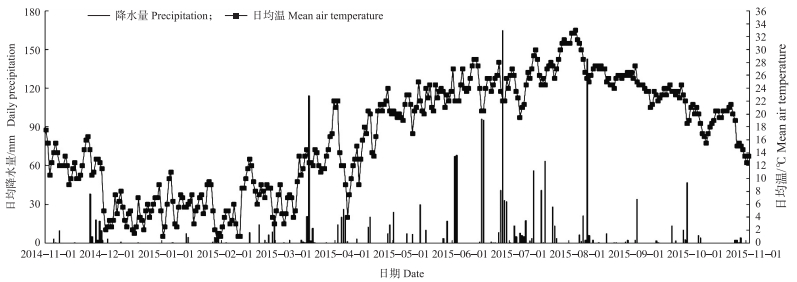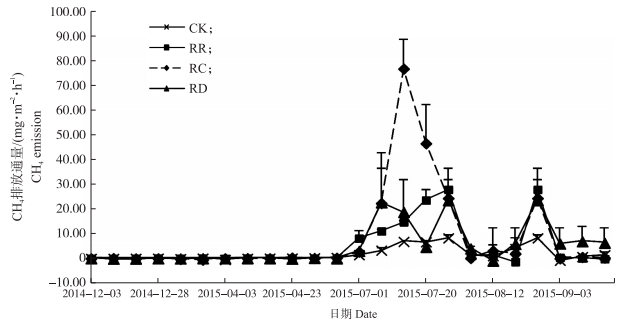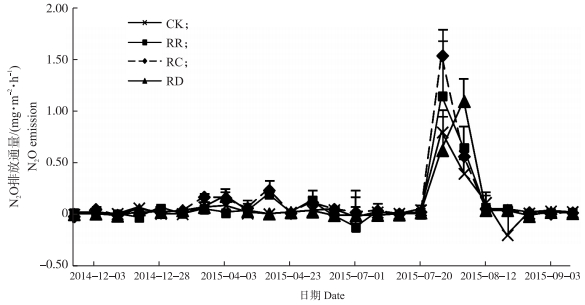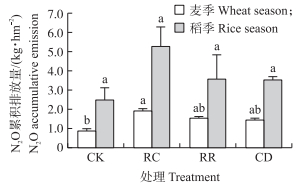文章信息
- 王保君, 胡乃娟, 顾泽海, 陈兵林, 陈利根, 朱利群
- WANG Baojun, HU Naijuan, GU Zehai, CHEN Binglin, CHEN Ligen, ZHU Liqun
- 稻秆还田方式对稻麦轮作农田CH4和N2O排放的影响
- Impact of rice straw return methods on CH4 and N2O emissions across a rice-wheat rotation
- 南京农业大学学报, 2017, 40(3): 367-375
- Journal of Nanjing Agricultural University, 2017, 40(3): 367-375.
- http://dx.doi.org/10.7685/jnau.201609014
-
文章历史
- 收稿日期: 2016-09-08
2. 南京农业大学公共管理学院, 江苏 南京 210095
2. College of Public Administration, Nanjing Agricultural University, Nanjing 210095, China
气候变暖是全球环境变化的突出问题, 据IPCC报道, 1880—2012年全球地表平均温度升高了0.85 ℃[1]。大气中温室气体排放的增加是引起全球气候变暖的重要原因[2-3]。人类活动产生的温室气体排放主要来源于工业与农业[4], 其中农业温室气体排放量约占全球总温室气体排放的13.5%[5]。农业管理措施包括施肥、灌溉和耕作方式等, 是影响农田温室气体排放的重要因素, 农业管理措施合理与否, 直接影响着农田温室气体的排放[6]。
中国作物秸秆资源丰富, 年均生产量达7.6~8.2亿t[7-8], 占世界秸秆资源产量的25%左右[9]。作物秸秆中富含大量的营养物质, 是重要的有机肥资源[10]。秸秆还田作为重要的农业生产管理措施, 在增加土壤有机质含量、循环补充土壤养分、维持农田肥力、减少化肥使用量且稳定作物产量等方面意义重大[11]。但是, 大量研究表明, 秸秆还田在提高土壤肥力的同时会增加农田温室气体的排放, 并且不同的秸秆还田方式下温室气体的排放差异很大[12-21]。因此, 明确某一区域不同秸秆还田方式下温室气体排放差异对于该地区选择合理的秸秆还田方式尤为重要。本研究在大田试验条件下, 通过设置稻秆集中沟埋还田、旋耕还田、表层覆盖和稻秆不还田等处理, 研究了不同秸秆还田方式下稻麦轮作农田温室气体排放的差异, 并测定了不同处理下的作物产量, 比较3种不同秸秆还田方式下的温室气体排放强度, 旨在为稻麦轮作农田选择合理的秸秆还田方式提供参考, 以期实现农田生态系统生产能力的可持续发展。
1 材料与方法 1.1 试验地概况试验于2014年11月至2015年6月在江苏省南京市江宁区青龙社区试验地 (118°85″E, 31°95″N) 开展。试验地属亚热带季风气候, 光照充足, 气候适宜, 该地年均气温15.7 ℃, 年均降水量1 072.9 mm, 年均日照时间2 135 h, 常年降水时间116.3 d, 无霜期230 d。试验田为稻麦两熟种植制度, 试验开始时的前茬作物为水稻, 试验田土壤质地为壤土, 土层深厚, 0~20 cm土层土壤基本理化性状为:有机质15.45 g·kg-1、全氮0.87 g·kg-1、速效磷5.44 mg·kg-1、速效钾58.17 mg·kg-1, pH7.47。
1.2 试验设计在小麦播种前进行稻秆还田, 采用随机区组设计, 共设4个处理:稻秆不还田 (CK)、稻秆旋耕还田 (RR)、稻秆表面覆盖还田 (RC)、稻秆集中沟埋还田 (RD), 具体试验设计如表 1所示。试验稻秆经人工粉碎成5~10 cm的稻草段。每个处理小区面积为30 m2(5 m×6 m), 重复3次。所有秸秆处理在水稻收获后1周内处理完毕。
| 处理 Treatment |
还田量/(t·hm-2) Application rate |
还田方式 Returning way |
| RD | 9 | 在小区内开挖2条平行沟渠 (长×宽×深:5 m×0.3 m×0.2 m), 每条沟渠掩埋长度为5~10 cm的稻秆13.5 kg (即2.7 kg·m-1), 然后进行旋耕 (深度0.1 m)。 |
| RR | 9 | 将27 kg长度为5~10 cm的稻秆均匀地覆盖在小区表面, 进行旋耕 (深度0.1 m), 使稻秆与麦田小区表面0.1 m土层均匀混合。 |
| RC | 9 | 将27 kg长度为5~10 cm的稻秆均匀地覆盖在已经旋耕 (深度0.1 m) 好的小区表面。 |
| CK | 0 | 将稻秆直接移出小区, 然后进行旋耕 (深度0.1 m)。 |
| 注: CK:稻秆不还田Without rice straw returning; RC:稻秆表面覆盖还田Rice straw covered returning; RR:稻秆旋耕还田Rice straw rotary returning; RD:稻秆集中沟埋还田Rice straw concentrated ditch-buried returning. The same as follows. | ||
供试小麦品种为‘生选3号’, 于2014年11月19日人工撒播, 播种量为150 kg·hm-2。氮肥总施用量 (以纯氮计) 为270 kg·hm-2, 按基肥、拔节肥用量比1:1施用, 基肥在播种当日施入, 拔节肥在2015年3月7日施入。磷、钾肥全部作基肥施用, 施用量均为67.5 kg·hm-2, 肥料具体施用时间和施用量如表 2所示。病、虫、草害防治和其他栽培管理措施与当地常规田间管理相同。小麦收获时间为2015年6月5日。
供试水稻品种为‘武育粳23号’, 于2015年6月22日人工移栽, 移栽叶龄为5叶, 移栽行距、株距分别为30 cm、13.5 cm, 每穴2株。氮肥总施用量 (以纯氮计) 为255 kg·hm-2, 基肥和拔节肥施用量分别为120和135 kg·hm-2, 其中基肥于移栽当日施入, 拔节肥于2015年7月20日施入。磷、钾肥全部作基肥施用, 施用量均为120 kg·hm-2, 肥料具体施用时间和施用量如表 2所示。各处理水稻生长期间水分管理模式相同, 分别为:6月22日至7月27日灌水保持5 cm浅水层, 7月28日至8月5日晒田, 8月6日至10月25日干湿交替, 10月27日至11月2日晒田。病、虫、草害防治和其他栽培管理措施与当地常规田间管理相同。水稻收获时间为2015年11月3日。
| 作物 Crop |
施肥方式 Fertilization |
化学肥料施用量 (m(N):m(P2O5):m(K2O))/(kg·hm-2) Chemical fertilizer application rate |
施用时间 (年-月-日) Application date (year-month-date) |
| 小麦Wheat | 基肥Basal | 135:67.5:67.5 | 2014-11-19 |
| 追肥Top dressing | 135:0:0 | 2015-03-07 | |
| 水稻Rice | 基肥Basal | 120:120:120 | 2015-06-22 |
| 追肥Top dressing | 135:0:0 | 2015-07-20 |
每季作物收获后, 按小区单收计小麦和水稻的实际产量。
1.4.2 气体的采集与测定2014年11月19日至2015年11月3日作物生长期对温室气体排放进行监测。稻麦轮作田温室气体的监测采用密闭静态暗箱-气相色谱法进行采集和测定[22]。静态暗箱装置是由黑色的PVC塑料制成的采样箱 (0.5 m×0.5 m×0.5 m或0.5 m×0.5 m×1.0 m, 由作物株高而定) 和底座 (0.5 m×0.5 m×0.3 m) 两部分组成。箱体内配置有温度探头 (检测箱体内温度)、空气搅拌风扇 (混合气体) 和气体采集管, 箱体外包有锡纸, 以减缓太阳辐射下采样箱和箱内温度上升过快, 尽量维持采样箱体内外温度相对一致。将底座下端插入5 cm的土体, 底座上端有密水槽, 抽气时向其中加入适量的水以保证箱体和底座之间密封。
稻季和麦季气样采集时间分别为09:00—12:00和12:00—15:00, 每周采集1次。每次采样时间控制在20 min内, 每5 min收集1次, 共连续采气4次。用带有三通阀的针筒采集气体, 将其注入特制的集气瓶中保存, 当天送回实验室进行测定。记录每次抽气时的箱内温度。CH4、N2O气体浓度采用气象色谱仪 (Agilent 7890A, 美国) 同步测定, 其中CH4用氢火焰离子检测器FID测定, N2O用63Ni电子捕获检测器ECD测定。温室气体监测期间的温度和降水情况见图 1。

|
图 1 2014年11月至2015年11月试验点降水和气温变化 Figure 1 Variation of daily precipitation and mean air temperature from 2014-11 to 2015-11 at research station |
根据每次4个气样的CH4和N2O浓度与时间关系曲线计算CH4和N2O的排放通量。气体排放通量计算公式如下[23]:

|
式中:F为气体排放通量 (mg·m-2·h-1); ρ为标准状态下气体的密度 (kg·m-3), h为采样箱高度 (m); dc/dt为采样箱内的气体浓度变化率; 273为气态方程常数; T为采样过程中采样箱内的平均温度 (℃)。
稻秆集中沟埋还田 (RD) 处理温室气体排放通量的计算:分别用静态箱-气相色谱法测量非沟埋区的温室气体排放通量 (F0)、沟区和非沟区域温室气体的混合排放通量 (F′), 即:

|
(1) |
式 (1) 中:S0、SD、S分别是采气箱内非沟埋区面积、采气箱箱内沟埋区面积和采气箱覆盖面积。其中, S0=(0.5-0.2)×0.5=0.15 m2; SD=0.2×0.5=0.1 m2; S=0.5×0.5=0.25 m2, 因此, 沟埋区域的气体排放通量 (FD) 为:

|
(2) |
稻秆沟埋还田处理的温室气体排放通量 (FRD) 为沟埋区和非沟埋区温室气体排放通量与对应区域面积的加权平均, 即:

|
(3) |
式 (3) 中:S0*、SD*、S*分别是小区非沟埋区域面积、小区沟埋区域面积、小区面积。其中, S0*=(5×6)-(2×5×0.3)=27 m2; SD*=2×5×0.3=3 m2; S*=5×6=30 m2, 因此稻秆集中沟埋还田处理的温室气体排放通量为:

|
(4) |
根据CH4和N2O在100年尺度上的全球增温潜势分别为CO2的28和265倍[24], 不同处理排放CH4和N2O产生的综合温室效应计算公式如下:

|
式中:GWP为CH4和N2O排放的综合温室效应 (kg·hm-2, 以CO2计); ECH4和EN2O分别为CH4和N2O排放总量 (kg·hm-2)。
温室气体排放强度计算公式[25]如下:

|
式中:GHGI为温室气体排放强度 (kg·t-1, 以CO2计); GWP为CH4和N2O的综合温室效应 (kg·hm-2, 以CO2计); Y为稻麦轮作田水稻和小麦的周年产量 (t·hm-2)。
用SPSS 20.0软件处理数据, Excel 2007软件制作图表, 数据采用Duncan′s法进行方差分析。
2 结果与分析 2.1 稻秆不同还田方式对稻麦轮作农田CH4排放的影响从图 2可见:在整个稻麦轮作期内, CK处理始终保持较低的CH4排放水平, 不同稻秆还田方式下CH4排放存在一定的差异, 并且差异主要体现在稻季, 麦季CH4的排放规律基本一致, 且几乎为0。水稻生长期间, 各处理的CH4排放峰出现时间、频率和大小不同。RR和RC均出现2次CH4排放峰, 峰值出现在水稻移栽后35、78 d和22、78 d, 大小分别为24.21、27.72 mg·m-2·h-1和76.27、24.21 mg·m-2·h-1。而RD出现了3次CH4排放峰, 峰值出现时间分别为水稻移栽后15、35和78 d, 大小分别为22.49、23.34和23.34 mg·m-2·h-1。这可能是因为在7月19日取气前3 d降雨过多, 埋草沟内积蓄大量的雨水, 土温降低[26], 土壤微生物活性受到影响, 从而降低了CH4的排放。在水稻整个生育期内, 不同处理的CH4排放主要集中在水稻前期, 由于8月中旬降水较多, 各处理在移栽78 d后均出现了小的排放峰, 但水稻生长后期CH4排放几乎为0。

|
图 2 稻秆还田方式对稻麦轮作区CH4周年排放的影响 Figure 2 Effects of the different rice straw returning methods on CH4 flux in a rice-wheat rotation |
从图 3可见:在稻麦轮作的整个生育期内, 不同稻秆还田方式下N2O排放规律基本一致, 但存在一定的差异。各处理麦季N2O排放均保持在较低水平, 且有负值出现。各处理N2O最大排放峰值出现在水稻生育期前期, RR和RC处理的N2O最大排放峰均出现在晒田期间 (移栽后42 d), 大小分别为1.14 mg·m-2·h-1和1.53 mg·m-2·h-1, 而RD处理的N2O最大排放峰出现在晒田后干湿交替期间 (移栽后49 d), 大小为1.10 mg·m-2·h-1。各处理在水稻移栽后10~12 d内并未出现峰值, 可能是由于水稻移栽1周内出现了连续的强降雨天气, 导致稻田跑水跑肥, 从而影响了测量结果。

|
图 3 稻秆还田方式对稻麦轮作区N2O季节周年排放的影响 Figure 3 Effects of the different rice straw returning methods on N2O flux in a rice-wheat rotation |
由图 4可以看出:稻麦轮作区CH4的排放主要集中于稻季, 麦季CH4排放较少。3种稻秆还田方式对CH4排放的影响存在一定的差异。在小麦生长期间, RR处理的CH4累积排放量显著高于RC处理 (P < 0.05);在水稻生长期间, RC处理的CH4累积排放量显著高于其他处理 (P < 0.05)。3种稻秆还田方式中, CH4周年累积排放量以RC为最大, RD为最小。与CK相比, RC、RR和RD 3种还田方式下CH4周年累积排放量分别增加了226.15、92.28和92.22 kg·hm-2。

|
图 4 稻秆还田方式对稻麦轮作区CH4累积排放量的影响 Figure 4 Effects of the different rice straw returning methods on CH4 accumulative emission in a rice-wheat rotation 不同字母表示同一作物生长季节不同处理间在0.05水平差异显著。 Different letters indicated that treatments were significantly different at 0.05 levels in the same crop growing season. |
由图 5可以看出:稻秆还田影响N2O累积排放量, 且不同还田方式之间存在一定的差异。在麦季, RC处理下N2O累积排放量显著高于CK (P < 0.05), 但与RR和RD之间差异不显著; 而在稻季, 不同处理对N2O累积排放量的影响均不显著。3种稻秆还田方式, N2O周年累积排放量以RC为最大, RD为最小。与CK相比, RC、RR和RD 3种还田方式下N2O周年累积排放量分别增加了3.78、1.72和1.60 kg·hm-2。

|
图 5 稻秆还田方式对稻麦轮作区N2O累积排放量的影响 Figure 5 Effects of the different rice straw returning methods on N2O accumulative emission in a rice-wheat rotation 不同字母表示同一作物生长季节不同处理间在0.05水平差异显著。 Different letters indicated that treatments were significantly different at 0.05 levels in the same crop growing season. |
由表 3可知:3种稻秆还田方式均可以增加稻麦轮作田周年作物产量。RD、RR、RC和CK 4种处理下的周年稻麦产量分别为14.74、14.33、13.68和13.43 t·hm-2, 以RD为最高。与CK相比, RD处理显著增产9.75%。与CK相比, 稻秆还田显著增加了稻麦轮作农田增温潜势, 其中RC处理的增温潜势显著高于其他处理。与CK相比, RC、RR和RD 3种还田方式的全球增温潜势分别显著增加了7 334.89、3 041.26和3 007.20 kg·hm-2(以CO2计)。3种还田方式下, 温室气体排放强度以RC为最大, RD为最小。
| 处理 Treatment |
周年累积排放量 Annual accumulative emissions |
作物总产量 Total yield |
全球增温潜势 Global warming potential |
温室气体排放强度 Greenhouse emission intensity |
||||
| CH4排放量/ (kg·hm-2) CH4 emission |
N2O排放量/ (kg·hm-2) N2O emissions |
小麦+水稻/ (t·hm-2) Wheat+rice |
小麦+水稻/ (kg·hm-2) Wheat+rice |
小麦+水稻/ (kg·t-1) Wheat+rice |
||||
| CK | 56.31±14.71b | 3.40±0.62b | 13.43±1.11b | 2 477.22±268.34c | 184.45±19.98c | |||
| RC | 282.46±53.25a | 7.18±1.02a | 13.68±1.57b | 9 812.11±501.99a | 717.26±36.70a | |||
| RR | 148.59±51.93ab | 5.12±1.27ab | 14.33±1.28a | 5 518.48±869.95b | 385.10±60.71b | |||
| RD | 148.53±71.29ab | 5.00±0.18ab | 14.74±1.05a | 5 484.42±914.83b | 372.07±62.06bc | |||
| 注:数据为平均值±标准差, 同列不同小写字母表示在0.05水平上差异显著。 Note: Values in the table are mean±standard deviation, with the same column, figures followed by different small letters show significant difference at 0.05 level. |
||||||||
CH4是仅次于CO2的重要温室气体, 农田土壤中的有机质在产甲烷菌作用下产生CH4[27], 是CH4重要的排放源。秸秆还田作为农业生产的重要环节, 在短期内对土壤有机质的影响较小, 对活性有机碳影响较大[28], 其主要通过改变土壤活性有机碳含量影响农田CH4的排放。本研究表明, 不同的稻秆还田方式对稻麦轮作农田CH4排放规律的影响主要体现在稻季, 对麦季CH4排放规律的影响较小。这是因为CH4的产生需要严格的厌氧环境[29], 而水稻种植季节具备厌氧条件, 因此不同的稻秆还田方式对稻麦轮作农田CH4排放规律的影响主要在稻季。本研究还表明, 在麦季, 稻秆旋耕还田的CH4排放总量显著高于稻秆表层覆盖还田处理, 而在稻季, 稻秆表层覆盖还田的CH4排放总量显著高于其他处理。这可能与不同的稻秆还田方式下秸秆腐解速率不同有关[30-31], 稻秆旋耕还田能够使秸秆与土壤充分混合, 有利于秸秆的腐解, 稻秆表层覆盖还田由于秸秆处于土壤表层, 缺少水分, 限制了秸秆的腐解速率[31], 而稻秆集中沟埋处理的秸秆与土壤的接触面积小, 隔绝空气, 腐解速率较慢[32]。因此, 在麦季, 稻秆旋耕还田下秸秆的腐解速率较其他还田方式快, 释放的活性有机碳含量也较高, 从而导致CH4排放高于其他处理[28]; 而在稻季, 各处理均不施入前茬麦秸秸秆, 直接对土地进行旋耕作业 (深度0.1 m), 由于表层覆盖还田的稻秆在前茬麦季腐解缓慢, 剩余的未腐解量多, 到水稻季时, 剩余的稻秆通过旋耕与土壤混合, 快速分解释放活性有机碳, 从而增加了CH4的排放量, 该结果与马二登等[33]的研究结果一致。
秸秆还田是重要的农田管理措施, 通过改善土壤N素状况影响农田N2O排放。本研究发现, 稻秆旋耕还田和稻秆表层覆盖还田处理的N2O排放峰均集中出现在水稻晒田期间, 而稻秆集中沟埋处理比其他处理要晚。这主要与田间土壤含水量有关, 晒田期间土壤干湿交替, 微生物的硝化和反硝化作用同时进行, 大大促进N2O排放[34-36], 而在沟埋还田处理下由于埋草沟的蓄水能力较强, 在同一时间段内, 稻秆集中沟埋还田处理较其他处理的含水量较高, 土壤达到干湿交替状态较其他处理要延迟一些, 因此排放高峰靠后[34-36]。此外, 本研究还表明, 稻秆还田处理增加了N2O排放, 其中稻秆表面覆盖处理下的N2O排放总量显著高于稻秆不还田处理, 其原因可能是秸秆的投入为N2O排放提供了充足的C和N底物, 从而刺激了N2O排放[37], 这与前人研究结果一致[19]。但也有报道指出有机肥的投入会减少农田温室气体N2O的排放[38-39]。这可能是因为N2O排放不仅与农田水分管理和外源碳、氮的供应有关, 而且与秸秆的C/N也有很大的关系[34]。
4 结论短期条件下, 与秸秆不还田相比, 3种稻秆还田方式均增加了稻麦轮作农田周年CH4和N2O的排放, 以稻秆覆盖还田为最高, 沟埋还田为最低。稻秆还田能提高小麦和水稻的周年产量, 稻秆覆盖还田、旋耕还田和沟埋还田分别比对照增加了1.86%、6.70%和9.75%。稻秆还田处理较不还田处理明显增加了温室气体排放强度, 在3种还田方式中, 稻秆沟埋还田下温室气体排放强度显著低于稻秆覆盖还田, 且低于稻秆旋耕还田。因此, 在稻麦轮作制度下, 与常规旋耕和覆盖还田相比, 稻秆集中沟埋还田是一种既能提高周年作物产量又可以减少温室气体排放的还田方式。
| [1] |
秦大河, StockerT. IPCC第五次评估报告第一工作组报告的亮点结论[J].
气候变化研究进展, 2014, 10(1): 1–6.
Qin D H, Stocker T. Highlights of the IPCC working groupⅠfifth assessment report[J]. Progressus Inquisitions Mutatione Climati, 2014, 10(1): 1–6. (in Chinese) |
| [2] |
葛全胜, 王芳, 王绍武, 等. 对全球变暖认识的七个问题的确定与不确定性[J].
中国人口·资源与环境, 2014, 24(1): 1–6.
Ge Q S, Wang F, Wang S W, et al. Certainty and uncertainty in global warming studies[J]. China Population, Resources and Environment, 2014, 24(1): 1–6. (in Chinese) |
| [3] | Rodhe H. A comparison of the contribution of various gases to the greenhouse effect[J]. Science, 1990, 248(4960): 1217–1219. DOI: 10.1126/science.248.4960.1217 |
| [4] |
方精云, 朱江玲, 王少鹏, 等. 全球变暖、碳排放及不确定性[J].
中国科学:地球科学, 2011, 41(10): 1385–1395.
Fang J Y, Zhu J L, Wang S P, et al. Global warming, human-induced carbon emissions, and their uncertainties[J]. Scientia Sinica:Terrae, 2011, 41(10): 1385–1395. (in Chinese) |
| [5] | Metz B, Davidson O, Bosch P, et al. Climate Change 2007 Mitigation of Climat Change:Working Group Ⅲ to the Fourth Assessment Report of the Intergovernmental Panel on Climate Change[R]. United Kingdom:Cambridge University Press, 2007. |
| [6] |
宋利娜, 张玉铭, 胡春胜, 等. 华北平原高产农区冬小麦农田土壤温室气体排放及其综合温室效应[J].
中国生态农业学报, 2013, 21(3): 297–307.
Song L N, Zhang Y M, Hu C S, et al. Comprehensive analysis of emissions and global warming effects of greenhouse gases in winter-wheat fields in the high-yield agro-region of North China Plain[J]. Chinese Journal of Eco-Agriculture, 2013, 21(3): 297–307. (in Chinese) |
| [7] |
韩继明, 潘根兴, 刘志伟, 等. 减氮条件下秸秆炭化与直接还田对旱地作物产量及综合温室效应的影响[J].
南京农业大学学报, 2016, 39(6): 986–995.
Han J M, Pan G X, Liu Z W, et al. Contrasting effect of straw return and its biochar on changes in crop yield and integrated global warming effects under different nitrogen levels[J]. Journal of Nanjing Agricultural University, 2016, 39(6): 986–995. DOI: 10.7685/jnau.201603033 (in Chinese) |
| [8] |
潘根兴, 李恋卿, 刘晓雨, 等. 热裂解生物质炭产业化:秸秆禁烧与绿色农业新途径[J].
科技导报, 2015, 33(13): 92–101.
Pan G X, Li L Q, Liu X Y, et al. Industrialization of biomass pyrolysis:a new option for straw burning and green agriculture of China[J]. Science and Technology Review, 2015, 33(13): 92–101. DOI: 10.3981/j.issn.1000-7857.2015.13.015 (in Chinese) |
| [9] |
姜超强, 郑青松, 祖朝龙. 秸秆还田对土壤钾素的影响及其替代钾肥效应研究进展[J].
生态学杂志, 2015, 34(4): 1158–1165.
Jiang C Q, Zheng Q S, Zu C L. Research progress on effects of straw returning on soil potassium and its substitute for potassium fertilize[J]. Chinese Journal of Ecology, 2015, 34(4): 1158–1165. (in Chinese) |
| [10] | Wang Y J, Bi Y Y, Gao C Y. The assessment and utilization of straw resources in China[J]. Agricultural Sciences in China, 2010, 9(12): 1807–1815. DOI: 10.1016/S1671-2927(09)60279-0 |
| [11] |
潘剑玲, 代万安, 尚占环, 等. 秸秆还田对土壤有机质和氮素有效性影响及机制研究进展[J].
中国生态农业学报, 2013, 21(5): 526–535.
Pan J L, Dai W A, Shang Z H, et al. Review of research progress on the influence and mechanism of field straw residue incorporation on soil organic matter and nitrogen availability[J]. Chinese Journal of Eco-Agriculture, 2013, 21(5): 526–535. (in Chinese) |
| [12] |
肖小平, 伍芬琳, 黄风球, 等. 不同稻草还田方式对稻田温室气体排放影响研究[J].
农业现代化研究, 2007, 28(5): 629–632.
Xiao X P, Wu F L, Huang F Q, et al. Greenhouse air emission under different pattern of rice-straw returned to field in double rice area[J]. Research of Agricultural Modernization, 2007, 28(5): 629–632. (in Chinese) |
| [13] |
王改玲, 郝明德, 陈德立. 硝化抑制剂和通气调节对土壤N2O排放的影响[J].
植物营养与肥料学报, 2006, 12(1): 32–36.
Wang G L, Hao M D, Chen D L. Effect of nitrification inhibitor and aeration regulation on soil N2O emission[J]. Plant Nutrition and Fertilizer Science, 2006, 12(1): 32–36. DOI: 10.11674/zwyf.2006.0106 (in Chinese) |
| [14] |
张岳芳, 陈留根, 张传胜, 等. 水稻机械化播栽对稻田甲烷和氧化亚氮排放的影响[J].
农业工程学报, 2015, 31(14): 232–241.
Zhang Y F, Chen L G, Zhang C S, et al. Influence of rice mechanical planting methods on methane and nitrous oxide emissions from paddy field[J]. Transactions of the Chinese Society of Agricultural Engineering, 2015, 31(14): 232–241. DOI: 10.11975/j.issn.1002-6819.2015.14.032 (in Chinese) |
| [15] |
崔新卫, 张杨珠, 吴金水, 等. 秸秆还田对土壤质量与作物生长的影响研究进展[J].
土壤通报, 2014, 45(6): 1527–1532.
Cui X W, Zhang Y, Wu J S, et al. Research progress on the effect s of returning straw to fields on soil quality and crop growth[J]. Chinese Journal of Soil Science, 2014, 45(6): 1527–1532. (in Chinese) |
| [16] |
夏文斌, 张旭辉, 刘铭龙, 等. 麦秆还田方式对旱地土壤综合温室效应的影响[J].
土壤, 2014, 46(6): 1010–1016.
Xia W B, Zhang X H, Liu M L, et al. Effects of wheat straw return ways on integrated global warming effect from dryland soil in north China plain[J]. Soils, 2014, 46(6): 1010–1016. (in Chinese) |
| [17] |
李新华, 朱振林, 董红云, 等. 秸秆不同还田模式对玉米田温室气体排放和碳固定的影响[J].
农业环境科学学报, 2015, 34(11): 2228–2235.
Li X H, Zhu Z L, Dong H Y, et al. Effects of different return modes of wheat straws on greenhouse gas emissions and carbon sequestration of maize fields[J]. Journal of Agro-Environment Science, 2015, 34(11): 2228–2235. DOI: 10.11654/jaes.2015.11.027 (in Chinese) |
| [18] |
张岳芳, 郑建初, 陈留根, 等. 麦秸还田与土壤耕作对稻季CH4和N2O排放的影响[J].
生态环境学报, 2009, 18(6): 2334–2338.
Zhang Y F, Zhen J C, Chen L G, et al. Effects of wheat straw returning and soil tillage on CH4 and N2O emissions in paddy season[J]. Ecology and Environmental Sciences, 2009, 18(6): 2334–2338. (in Chinese) |
| [19] |
马二登, 马静, 徐华, 等. 稻秆还田方式对麦田N2O排放的影响[J].
土壤, 2007, 39(6): 870–873.
Ma E D, Ma J, Xu H, et al. Effects of rice straw returning methods on N2O emissions from wheat-growing season[J]. Soil, 2007, 39(6): 870–873. (in Chinese) |
| [20] |
苏伟, 鲁剑巍, 周广生, 等. 稻草还田对油菜生长、土壤温度及湿度的影响[J].
植物营养与肥料学报, 2011, 17(2): 366–373.
Su W, Lu J W, Zhou G S, et al. Influence of straw-returning on rapeseed (Brassica napus L.) growth, soil temperature and moisture[J]. Plant Nutrition and Fertilizer Science, 2011, 17(2): 366–373. DOI: 10.11674/zwyf.2011.0287 (in Chinese) |
| [21] |
李波, 魏亚凤, 季桦, 等. 水稻秸秆还田与不同耕作方式下影响小麦出苗的因素[J].
扬州大学学报:农业与生命科学版, 2013, 34(2): 60–63.
Li B, Wei Y F, Ji Y, et al. Factor affecting seeding emergence in winter wheat under different tillage patterns with rice straw mulching[J]. Journal of Yangzhou University:Agricultural and Life Science Edition, 2013, 34(2): 60–63. (in Chinese) |
| [22] |
邹建文, 焦燕, 王跃思, 等. 稻田CO2、CH4和N2O排放通量测定方法研究[J].
南京农业大学学报, 2002, 25(4): 45–48.
Zou J W, Jiao Y, Wang Y S, et al. GC-based technique for determination of CO2, CH4and N2O emissions from paddy fields[J]. Journal of Nanjing Agricultural University, 2002, 25(4): 45–48. DOI: 10.7685/j.issn.1000-2030.2002.04.011 (in Chinese) |
| [23] |
蔡祖聪, 徐华, 马静.
稻田生态系统CH4和N2O的排放[M]. 合肥: 中国科学技术大学出版社, 2009.
Cai Z C, Xu H, Ma J. Methane and Nitrous Oxide Emission from Rice-based Ecosystems[M]. Hefei: University of Science and Technology of China Press, 2009. (in Chinese) |
| [24] | Intergovernmental Panel on Climate Change (IPCC). Climate Change 2013:The Physical Science Basis Contribution of Working GroupⅠto the Fifth Assessment Report of the IPCC[M]. Cambridge, New York: Cambridge University Press, 2013. |
| [25] |
李建政, 王迎春, 王立刚, 等. 农田生态系统温室气体减排技术评价指标[J].
应用生态学报, 2015, 26(1): 297–303.
Li J Z, Wang Y C, Wang L G, et al. Evaluation indices of greenhouse gas mitigation technologies in cropland ecosystem[J]. Chinese Journal of Applied Ecology, 2015, 26(1): 297–303. (in Chinese) |
| [26] |
李彩霞, 周新国, 孙景生, 等. 不同沟灌方式下土壤水、热分布研究[J].
中国农学通报, 2014, 30(5): 158–164.
Li C X, Zhou X G, Sun J S, et al. The distribution of the water and temperature under different furrow irrigation methods[J]. Chinese Agricultural Science Bulletin, 2014, 30(5): 158–164. DOI: 10.11924/j.issn.1000-6850.2013-1179 (in Chinese) |
| [27] | Le Mer J, Roger P. Production, oxidation, emission and consumption of methane by soils:a review[J]. European Journal of Soil Biology, 2001, 37(1): 25–50. DOI: 10.1016/S1164-5563(01)01067-6 |
| [28] |
黄坚雄, 陈源泉, 隋鹏, 等. 农田温室气体净排放研究进展[J].
中国人口·资源与环境, 2011, 21(8): 87–94.
Huang J X, Chen Y Q, Sui P, et al. Research progress of net emission of farmland greenhouse gases[J]. China Population, Resources and Evironment, 2011, 21(8): 87–94. (in Chinese) |
| [29] |
郑立臣, 解宏图, 张威, 等. 秸秆不同还田方式对土壤中溶解性有机碳的影响[J].
生态环境, 2006, 15(1): 80–83.
Zheng L C, Xie H T, Zhang W, et al. Effects of different ways of returning straw to the soils on soluble organic carbon[J]. Ecology and Environment, 2006, 15(1): 80–83. (in Chinese) |
| [30] |
胡宏祥, 程燕, 马友华, 等. 油菜秸秆还田腐解变化特征及其培肥土壤的作用[J].
中国生态农业学报, 2012, 20(3): 297–302.
Hu H X, Cheng Y, Ma Y H, et al. Decomposition characteristics of returned rapeseed straw in soil and effects on soil fertility[J]. Chinese Journal of Eco-Agriculture, 2012, 20(3): 297–302. (in Chinese) |
| [31] |
李新举, 张志国, 李贻学. 土壤深度对还田秸秆腐解速度的影响[J].
土壤学报, 2001, 38(1): 135–138.
Li X J, Zhang Z G, Li Y X. Effects of soil depth on decay speed of straw[J]. Acta Pedologica Sinica, 2001, 38(1): 135–138. DOI: 10.11766/trxb199908070120 (in Chinese) |
| [32] |
吴俊松, 刘建, 刘晓菲, 等. 稻麦秸秆集中沟埋还田对麦田土壤物理性状的影响[J].
生态学报, 2016, 36(7): 2066–2075.
Wu J S, Liu J, Liu X F, et al. Effects of rice and wheat straw ditch-buried returns on the soil physical properties of wheat field[J]. Acta Ecological Sinica, 2016, 36(7): 2066–2075. (in Chinese) |
| [33] |
马二登, 马静, 徐华, 等. 麦季稻秆还田方式对后续稻季CH4排放的影响[J].
生态环境学报, 2010, 19(3): 729–732.
Ma E D, Ma J, Xu H, et al. Effects of rice straw returning methods in wheat-growing season on CH4 emissions from following rice-growing season[J]. Ecology and Environmental Sciences, 2010, 19(3): 729–732. (in Chinese) |
| [34] |
郭腾飞, 梁国庆, 周卫, 等. 施肥对稻田温室气体排放及土壤养分的影响[J].
植物营养与肥料学报, 2016, 22(2): 337–345.
Guo T F, Liang G Q, Zhou W, et al. Effect of fertilizer management on greenhouse gas emission and nutrient status in paddy soil[J]. Journal of Plant Nutrition and Fertilizer, 2016, 22(2): 337–345. DOI: 10.11674/zwyf.14557 (in Chinese) |
| [35] | Dobbie K E, Smith K A. Nitrous oxide emission factors for agricultural soils in Great Britain:the impact of soil water-filled pore space and other controlling variable[J]. Global Change Biology, 2003, 9: 204–218. DOI: 10.1046/j.1365-2486.2003.00563.x |
| [36] |
陈哲, 陈媛媛, 高霁, 等. 不同施肥措施对黄河上游灌区油葵田土壤N2O排放的影响[J].
应用生态学报, 2015, 26(1): 129–139.
Chen Z, Chen Y Y, Gao J, et al. Effects of different fertilization measures on N2O emission in oil sunflower field in irrigation area of upper Yellow River[J]. Chinese Journal of Applied Ecology, 2015, 26(1): 129–139. (in Chinese) |
| [37] | Hu N J, Wang B J, Gu Z H, et al. Effects of different straw returning modes on greenhouse gas emissions and crop yields in a rice-wheat rotation system[J]. Agriculture, Ecosystems and Environment, 2016, 223: 115–122. DOI: 10.1016/j.agee.2016.02.027 |
| [38] | Yao Z S, Zhou Z W, Zheng X H, et al. Effects of organic matter incorporation on nitrous oxide emissions from rice-wheat rotation ecosystems in China[J]. Plant and Soil, 2010, 327(1/2): 315–330. |
| [39] | Aulakh M S, Khera T S, Doran J W, et al. Denitrification, N2O and CO2 fluxes in rice-wheat cropping system as effected by crop residues, fertilizer N and legume green manure[J]. Biology and Fertility of Soils, 2001, 34(6): 375–389. DOI: 10.1007/s003740100420 |




